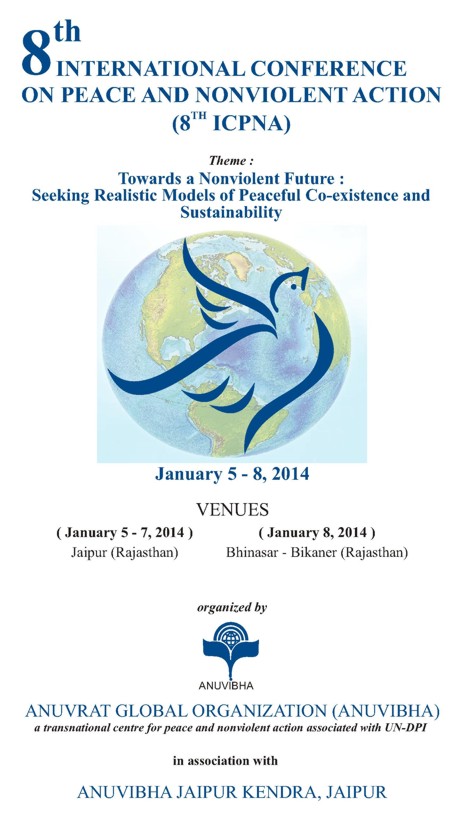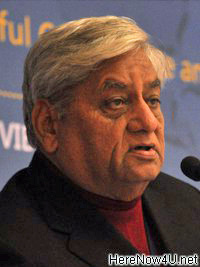 | 8th International Conference on Peace and Nonviolent Action |
Inaugural Session
Today the world is frightened by violence, counter-violence and terrorism. We are surrounded by an environment of fear and peacelessness. Instead of controlling and disciplining the self, man’s tendency to control and dominate others is getting stronger and stronger. Human propensities such as blind race for power and prosperity, materialistic glamour, unrestrained greed, envy and arrogance of wealth are pushing man towards violence. Sattva – the purity of heart and mind is disappearing gradually from social life and under the influence of rajas (passion) and tamas (darkness) man’s conduct continues to be destructive. As a result he doesn’t even hesitate to strike mercilessly at the mother earth. Environmental and ecological degradation is threatening the very existence of life on this planet. There is an unprecedented crisis of sustainability. In such a difficult situation the right thinking people from across the world have begun to think of nonviolence again. It is heartening to see such a large number of people from India and abroad who have come here from such a long distance in search of a nonviolent future.
Today, every religion in the world is worried about violence, man is inherently non-violent. Frankly speaking, most people don’t even know what non-violence means. They teach in great details about violence and say “please do avoid certain acts and you are a non-violent person.” People giving such discourses may not understand non-violence, but they definitely understand ‘violence’. We can see that most youths today have become experts in all forms of violence. It is a negative approach on the one hand as well as a prohibitive one on the other. Violence always remains alive (active) in a person’s thoughts. It becomes the nature of that person. It explodes with every incident. Envy, counter-violence etc. further the cause of violence. In the epic ‘Mahabharata’ Acharya Drona, Karna, and Duryodhana are considered the examples of counter-violence or vengeance in India.
Violence or nonviolence, they are expressions (feelings) of the heart. Unless there is a desire in the heart, there is no action possible through the physical body. The body has no action of its own. It is the pranas that move this body. pranas are activated by the accepted desires of the heart. If someone nurtures violent thoughts, they will explode when a provocative situation is created.
Osho has written that the non-vegetarian food changes a person’s skin which begins to resemble the skin of an animal itself. One gradually becomes a part of the animal in body, which administers the human body like that of the animal. This behavior turns the skin of the body into a non-porous wall like leather. The body no more remains transparent. This is one reason why all animals are not intelligent.
Lord Mahavira said that a jiva (living essence in every being) becomes heavy by acts of violence, by destroying the life forces of other living beings. It is a very important statement. As a matter of fact a jiva grows heavy by the memory of violence of his past life. When a person commits violence on account of the rise of karmas or memory of the samskaras (formative influence) of his previous lives, it is his memory of the violence of past samskaras that becomes its basis. By becoming a part of our nature, these memories incite us for violence. One’s memory is the real violence. Violent actions are not that dangerous. The memory of violence is what makes one violent. We either act through memories or through the imagination of the future. We become heavy in thought, word and deed. If there is no memory of violence in the mind and no such samskaras of the past, the present day violence is not possible. Those who are involved in acts of violence today, carry samskaras, nature of memory of violence in their hearts. The memory of that samskara of violence is awakened. Therefore, the basis of violence lies more in the memory of violence than in the present act of violence. The violent action is the result and not the root.
Acharya Mahapragya was of the view that as our consciousness or the level of awareness develops to a higher level, violence will stop automatically. It cannot stop by mere abstinence from it or by violent actions. It can be ended only by awakening consciousness. It erases the samskaras or memories and impression. Then one forgets the incidents or the memories. There is some wisdom or refulgence beneath our materialism which takes all decisions which reach out to the world beyond. Within us lies our existence - “I am”. Our external existence asserts - “I am special; I look out; I look inward.”
We always look at others and talk about them, forgetting ourselves. Osho emphasizes here - “Those who have courage, create problems for others, those who are weak trouble themselves. They are afraid of the brave people.” There is no risk in troubling oneself. He becomes self-destructive. A religious person is non-violent by nature, he neither troubles himself nor others.
Even if a person speaks the truth he does so to hurt others. It is not necessary that the truth is always bitter. One takes delight not in truth but in bitterness. Our untruth is very sweet because we want that it should prevail. We find that what a person prepares to speak and what he actually speaks are different. He even feels that something was left out when he spoke.
Our emotions are also a form of samskaras. They come to us as the results of our past samskaras and are also imparted to us by our mothers during pregnancy. Of course, later in life, the people around us, friends, incidents, environment, music etc, do change these samskaras. Today, our education system is devoid of values, wisdom and humaneness. Television, internet and other forms of media control the quality, quantity and direction of our thoughts. It reflects only indiscipline, violence and lack of concern for others. The streams that may put an end to this state of unrest have dried. Neither parents, teachers nor religion have any sway over people. Our actions and results nurture ‘violence’. Yet in the end we all talk of spirituality, of the soul, of consciousness and our existence. It’s our inner light which reflects externally.
In Jainism, our intentions or feelings are considered are the sources of violence or nonviolence. In this tradition when we talk of violence or nonviolence our intention or feeling remains at the centre. The activities of the body, speech and mind are directed by auspicious or inauspisicous karmic bondage. In Jainism mental violence is considered more heinous than verbal and physical violence. The seeds of both violence and nonviolence first sprout in the mind. If a man’s mind is not pure, his language and deeds will always remain soaked in violence. Pure feelings make a person refined. Bhavana Yoga (a yoga that refines our emotions) makes a man’s soul pure and pious. For the protection of the great vow of nonviolence a defence line consisting of five rules has been created. In addition to five great vows a monk or a nun takes he or she is also enjoined to walk carefully, use words in a controlled manner, be careful while begging, handle things they carry carefully. A man walks, speaks, exchanges things and also discards things. While performing these activities, a sadhak (aspirant) has to remain constantly wakeful so that he may avoid violence.
Nonviolence is, in reality, an inner awakening. When a person is able to control his senses and begins to look within, it is then that nonviolence sprouts. Nonviolence is the best religion. It is superb and a gateway to liberation. Is man’s mind biologically so constructed that it is bound to be violent? In order to discuss this question and get an answer to it, UNESCO convened an international seminar in Seville in the year 1985 in which selected scientists, anthropologists, sociologists from across the world were invited. They issued a statement at the end which runs as under -
‘The seeds of both war and peace originate in human mind. The mind that creates war can also create peace.’
In order to move towards a nonviolent future we will have to fathom the profound depths of the layers of nonviolence.
 Dr. Gulab Kothari
Dr. Gulab Kothari